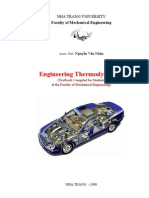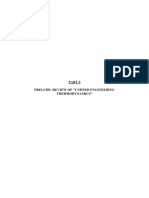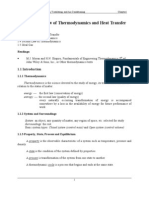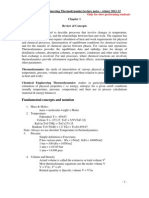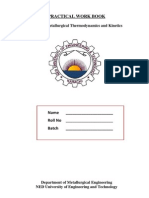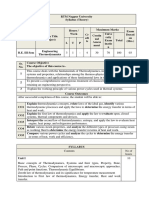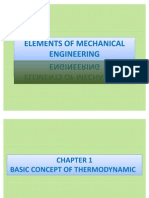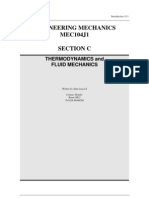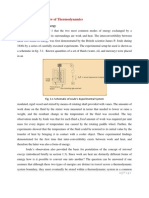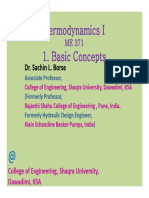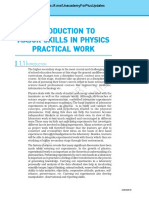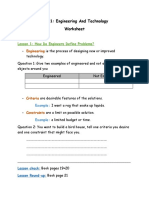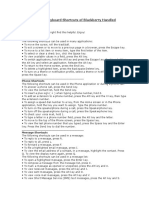Thermodynamics: Course Introduction
Thermodynamics: Course Introduction
Uploaded by
Rodrigo Silveira da SilveiraCopyright:
Available Formats
Thermodynamics: Course Introduction
Thermodynamics: Course Introduction
Uploaded by
Rodrigo Silveira da SilveiraOriginal Title
Copyright
Available Formats
Share this document
Did you find this document useful?
Is this content inappropriate?
Copyright:
Available Formats
Thermodynamics: Course Introduction
Thermodynamics: Course Introduction
Uploaded by
Rodrigo Silveira da SilveiraCopyright:
Available Formats
- 1 -
UNIFIED ENGINEERING 2000
Lecture Outlines Ian A. Waitz
THERMODYNAMICS:
COURSE INTRODUCTION
Course Learning Objectives:
To be able to use the First Law of Thermodynamics to estimate the potential for thermo-
mechanical energy conversion in aerospace power and propulsion systems.
Measurable outcomes (assessment method) :
1) To be able to state the First Law and to define heat, work, thermal efficiency and
the difference between various forms of energy. (quiz, self-assessment, PRS)
2) To be able to identify and describe energy exchange processes (in terms of
various forms of energy, heat and work) in aerospace systems. (quiz, homework,
self-assessment, PRS)
3) To be able to explain at a level understandable by a high school senior or non-
technical person how various heat engines work (e.g. a refrigerator, an IC engine,
a jet engine). (quiz, homework, self-assessment, PRS)
4) To be able to apply the steady-flow energy equation or the First Law of
Thermodynamics to a system of thermodynamic components (heaters, coolers,
pumps, turbines, pistons, etc.) to estimate required balances of heat, work and
energy flow. (homework, quiz, self-assessment, PRS)
5) To be able to explain at a level understandable by a high school senior or non-
technical person the concepts of path dependence/independence and
reversibility/irreversibility of various thermodynamic processes, to represent these
in terms of changes in thermodynamic state, and to cite examples of how these
would impact the performance of aerospace power and propulsion systems.
(homework, quiz, self-assessment, PRS)
6) To be able to apply ideal cycle analysis to simple heat engine cycles to estimate
thermal efficiency and work as a function of pressures and temperatures at various
points in the cycle. (homework, self-assessment, PRS)
Teaching & Learning Methods
1) Detailed lecture notes are available on the web (for viewing and/or downloading).
You should download a copy of these and bring them with you to lecture.
2) Preparation and participation will be important for learning the material. You will
be responsible for studying the notes prior to each lecture. Several reading
- 2 -
assignments will be given to help promote this activity (1/3 of participation
grade).
3) Several active learning techniques will be applied on a regular basis (turn-to-your-
partner exercises, muddiest part of the lecture, and ungraded concept quizzes).
We will make extensive use of the PRS system (2/3 of participation grade).
4) Homework problems will be assigned (approximately one hour of homework per
lecture hour). The Unified Engineering collaboration rules apply.
- 3 -
UNIFIED ENGINEERING 2000
Lecture Outlines Ian A. Waitz
THERMODYNAMICS CONCEPTS
I. Thermodynamics (VW, S & B: Chapter 1)
A. Describes processes that involve changes in temperature,
transformation of energy, relationships between heat and work.
B. It is a science, and more importantly an engineering tool, that is
necessary for describing the performance of propulsion systems,
power generation systems, refrigerators, fluid flow, combustion,
....
C. Generalization of extensive empirical evidence (however most
thermodynamic principles and can be derived from kinetic
theory)
D. Examples of heat engines
Combustion Heat
Solar Heat
Nuclear Heat
]
]
]
]
]
Heat Engine
[ ]
Mechanical Work
Electrical Energy
]
]
]
Waste Heat
[ ]
OR
Mechanical Work
Electrical Energy
]
]
]
Heat [ ]
Fuel
Air + fuel
V2, T2
Air
V1, T1
Waste Heat
Electricity Fuel
Air
Electricity
Heat
1. propulsion system 2. power generation 3. Refrigerator
- 4 -
E. Questions:
1. Describe the energy exchange processes in ___________ (fill in the blank,
e.g. a nuclear power plant, a refrigerator, a jet engine).
2. Given that energy is conserved, where does the fuel+oxidizer energy that is
used to power an airplane go?
3. Describe the energy exchange processes necessary to use electricity from a
nuclear power plant to remove heat from the food in a refrigerator.
4. Describe the energy exchange processes necessary for natural gas to be used
to provide electricity for the lights in the room you are in.
II. Concept of a thermodynamic system (VW, S & B: 2.1)
A. A quantity of matter of fixed identity, boundaries may be fixed or
movable, can transfer heat and work across boundary but not
mass
Force x distance (work)
System boundary
Heat (Q)
Electrical energy
(work)
System boundary
B. Identifiable volume with steady flow in and out, a control volume.
Often more useful way to view devices such as engines
System boundary
complex
process
m, p
1
,T
1
m, p
2
,T
2
- 5 -
III. Thermodynamic state of a system
A. The thermodynamic state of a system is defined by specifying a set
of measurable properties sufficient so that all remaining
properties are determined. Examples of properties: pressure,
temperature, density, internal energy, enthalpy, and entropy.
B. For engineering purposes we usually want gross, average,
macroscopic properties (not what is happening to individual
molecules and atoms) thus we consider substances as continua --
the properties represent averages over small volumes. For
example, there are 10
16
molecules of air in 1 mm
3
at standard
temperature and pressure. (VW, S & B: 2.2)
. Intensive properties do not depend on mass (e.g. p, T, , v=1/, u
and h); extensive properties depend on the total mass of the
system (e.g. V, M, U and H). Uppercase letters are usually used
for extensive properties. (VW, S & B: 2.3)
D. Equilibrium: States of a system are most conveniently described
when the system is in equilibrium, i. e. it is in steady-state. Often
we will consider processes that change slowly -- termed quasi-
steady. (VW, S & B: 2.3-2.4)
Force
Pressure Area
Gas 1
T
1
Gas 2
T
2
Gas 1
T
3
Gas 2
T
3
Wait
copper
boundary
thermally insulated
1. mechanical equilibrium 2. thermal equilibrium
(force balances pressure times area) (same temperature)
- 6 -
E. Two properties are needed to define the state of any pure
substance undergoing a steady or quasi-steady process. (This is
an experimental fact!) (VW, S & B: 3.1, 3.3)
1. For example for a thermally perfect gas (this is a good engineering
approximation for many situations, but not all (good for p<<p
crit
, and T>2T
crit
up to about 4p
crit
). (VW, S & B: 3.4):
p v = RT
v is volume per mol of gas, R is the universal gas constant R =
8.31kJ/Kmol-K. Dividing by molecular weight,
p v/M = (R / M ) T
where M is the molecular weight of the gas. Most often written as
pv = RT or p = RT
where v is the specific volume and R is the gas constant (which varies
depending on the gas. R = 287J/kg - K for air).
Thus, if we know p and T we know , if we know T and , we know p,
etc.
F. For thermodynamic processes we are interested in how the state
of a system changes. So typically we plot the behavior as shown
below. It is useful to know what a constant temperature line
(isotherm) looks like on a p-v diagram, what a constant volume
line (isochor) looks like on a T-p diagram, etc.
- 7 -
0.5 0.75 1.0 1.25 1.5
50
100
150
200
250
300
Specific Volume (m
3
/kg)
P
r
e
s
s
u
r
e
(
k
P
a
)
1.p-v diagram
200 300 400 500 600
50
100
150
200
250
300
Temperature (Kelvin)
P
r
e
s
s
u
r
e
(
k
P
a
)
2. p-T diagram
Increasing
Temperature
Increasing
Specific
Volume
- 8 -
200
250
300
350
400
450
500
550
600
T
e
m
p
e
r
a
t
u
r
e
(
K
e
l
v
i
n
)
0.5 0.75 1.0 1.25 1.5
Specific Volume (m
3
/kg)
3. T-v diagram
G. Note that real substances may have phase changes (water to water
vapor, or water to ice, for example). Many thermodynamic
devices rely on these phase changes (liquid-vapor power cycles are
used in many power generation schemes, for example). You will
learn more about these in 16.050. In this course we will deal only
with single-phase thermodynamic systems.
Increasing
pressure
- 9 -
Pressure-temperature-volume surface for a substance that expands on freezing
(fromVW, S & B: 3.7)
- 10 -
UNIFIED ENGINEERING 2000
Lecture Outlines Ian A. Waitz
CHANGING THE STATE OF A SYSTEM
WITH HEAT AND WORK
- Changes in the state of a system are produced by interactions with the
environment through heat and work .
- During these interactions, equilibrium (a static or quasi-static process) is
necessary for the equations that relate system properties to one-another to be
valid.
I. Changing the State of a System : Heat (VW, S & B: 4.7-4.9)
A. Heat is energy transferred between a system and its surroundings
by virtue of a temperature difference only.
1. This transfer of energy can change the state of the system.
2. Adiabatic means no heat is transferred.
B. Zeroth Law of Thermodynamics (VW, S & B: 2.9-2.10)
1. There exists for every thermodynamic system in equilibrium a property called
temperature. (Absolute temperature scales: K = 273.15+
o
C, R = 459.9 +
o
F)
2. Equality of temperature is a necessary and sufficient condition for thermal
equilibrium, i.e. no transfer of heat.
- 11 -
1
2
3
(thermometer)
1
3
if T
1
= T
2
and T
2
= T
3
then
1
Q
3
= 0
II. Changing the State of a System: Work (VW, S & B: 4.1-4.6)
A. Definition of Work
We saw that heat is a way of changing the energy of a system by virtue of a
temperature difference only.
Any other means for changing the energy of a system is called work. We can
have push-pull work (e.g. in a piston-cylinder, lifting a weight), electric and
magnetic work (e.g. an electric motor), chemical work, surface tension work,
elastic work, etc.
In defining work, we focus on the effects that the system (e.g. an engine) has on
its surroundings. Thus we define work as being positive when the system does
work on the surroundings (energy leaves the system). If work is done on the
system (energy added to the system), the work is negative.
- 12 -
B. Consider a simple compressible substance
Work done by system
dW Force dl
dW
Force
Area
|
(
`
J
Area dl ( )
dW Pr essure dVolume
dW p
ext
dV
therefore:
W p
ext
dV
V
1
V
2
or in terms of the specific
volume, v:
W m p
ext
dv
v
1
v
2
where m is the mass of the
system.
Area
p
external p
system
dl
V
P
ext
V
2
V
1
1. If system volume expands against a force, work is done by the system.
2. If system volume contracts under a force, work is done on the system.
3. Why p
external
instead of p
system
?
Consider p
external
= 0 (vacuum). No work is done by the system
even though p
system
changes and the system volume changes.
C. Quasi-static processes
Use of p
ext
instead of p
sys
is often inconvenient because it is usually the state of the
system that we are interested in.
However, for quasi-static processes p
sys
p
ext.
.
Consider p
ext
= p
sys
dp
- 13 -
W p
ext
dV
V
1
V
2
p
sys
dp
( )
dV
V
1
V
2
p
sys
dV dpdV
V
1
V
2
therefore
W p
sys
dV
V
1
V
2
is the work done by the system in a quasi-static process.
1. Can only relate work to system pressure for quasi-static processes.
2. Take a free expansion (p
ext
= 0) for example: p
sys
is not related to p
ext
( and
thus the work) at all -- the system is not in equilibrium.
D. Work is a path dependent process
1. Work depends on path
2. Work is not a function of the state of a system
3. Must specify path if we need to determine work
V
p
2V
0
V
0
2p
0
p
0
a
b
1
2
Along Path a: W = 2p
0
(2V
0
- V
0
) = 2p
0
V
0
Along Path b: W = p
0
(2V
0
- V
0
) = p
0
V
0
- 14 -
4. Question: Given a piston filled with air, ice, a bunsen burner, and a stack of
small weights, describe how you would use these to move along either path a
or path b above. When you move along either path how do you physically
know the work is different?
5. Example : Work during quasi-static, isothermal expansion of a thermally
perfect gas from p
1
, V
1
to p
2
, V
2
.
First, is path specified? Yes -- isothermal.
V
p
i
s
o
t
h
e
r
m
Equation of state for thermally perfect gas
pV = nRT n = number of moles
R = Universal gas constant
V = total system volume
W
nRT
V
dV
V
1
V
2
nRT
dV
V
V
1
V
2
nRT ln
V
2
V
1
|
(
'
`
J
J
also for T = constant, p
1
V
1
= p
2
V
2
, so the work done by the system is
W nRT ln
V
2
V
1
|
(
'
`
J
J
nRT ln
p
1
p
2
|
(
'
`
J
J
or in terms of the specific volume and the system mass
W mRT ln
v
2
v
1
|
(
'
`
J
J
mRT ln
p
1
p
2
|
(
'
`
J
J
E. Work vs. heat transfer -- which is which?
1. Can have one, the other, or both. It depends on what crosses the system
boundary. For example consider a resistor that is heating a volume of water.
- 15 -
2. If the water is the system, then the state of the system will be changed by heat
transferred from the resistor.
3. If the system is the water + the resistor, then the state of the system will be
changed by (electrical) work.
- 16 -
UNIFIED ENGINEERING 2000
Lecture Outlines Ian A. Waitz
FIRST LAW OF THERMODYNAMICS:
CONSERVATION OF ENERGY
I. First Law of Thermodynamics (VW, S & B: 2.6)
A. There exists for every system a property called energy. E = internal
energy (arising from molecular motion - primarily a function of
temperature) + kinetic energy + potential energy + chemical
energy.
1. Defines a useful property called energy.
2. The two new terms in the equation (compared to what you have seen in
physics and dynamics, for example) are the internal energy and the chemical
energy. For most situtations in this class, we will neglect the chemical energy.
3. Lets focus on the internal energy, u. It is associated with the random or
disorganized motion of the particles.
add heat
T
1
T
2
(molecular motion) (molecular motion)
u is a function of the state of the system. Thus u = u (p, T), or u = u (p, v), or
u = u(v,T). Recall that for pure substances the entire state of the system is
specified if any two properties are specified. We will discuss the equations
that relate the internal energy to these other variables later in the class.
B. The change in energy of a system is equal to the difference
between the heat added to the system and the work done by the
system. (This tells what the property energy is useful for.) (VW, S
& B: Chapter 5)
- 17 -
E = Q - W (units are Joules)
1. The signs are important (and sometimes confusing!)
E is the energy of the system
Q is the heat transferred to the system (positive) - if it is transferred
from the system Q is negative. (VW, S & B: 4.7-4.8)
W is the work done by the system (positive) - if work is done on
the system W is negative. (VW, S & B: 4.1-4.4)
2. The equation can also be written on a per unit mass basis
e = q - w (units are J/kg)
3. In many situations the potential energy and the kinetic energy of the system
are constant.
Then e = u, and
u = q - w or U = Q - W
Q and W are path dependent, U is not it depends only on the state of the
system, not how the system got to that state.
4. Can also write the first law in differential form:
dU = Q - W or du = q - w
Here the symbol is used to denote that these are not exact differentials but
are dependent on path.
5. Or for quasi-static processes
dU = Q - pdV or du = q - pdv
6. Example: Heat a gas, it expands against a weight. Force (pressure times area)
is applied over a distance, work is done.
- 18 -
Heat (Q)
weight
Pressure
Area
weight
Pressure
7. We will see later that the First Law can be written for a control volume with
steady mass flow in and steady mass flow out (like a jet engine for example).
We will call this the Steady-Flow Energy Equation. (VW, S & B: 5.8-5.12)
8. We will spend most of the course dealing with various applications of the first
law - in one form or another.
II. Corollaries of the First Law
A. Work done in any adiabatic (Q=0) process is path independent.
U = Q - W
U
1 U
2
a
b
0
B. 2. For a cyclic process heat and work transfers are numerically
equal
2
1
U
final
= U
initial
therefore U = 0
and Q = W
or Q W
- 19 -
III. Example applications of the First Law to motivate the use
of a property called enthalpy (VW, S & B: 5.4-5.5)
A. The combination u+pv shows up frequently so we give it a name:
enthalpy h= u+pv (or H = U+pV). It is a function of the state
of the system.
The utility and physical significance of enthalpy will be clearer when we discuss
the steady flow energy equation in a few lectures. For now, you may wish to
think of it as follows (Levenspiel, 1996). When you evaluate the energy of an
object of volume V, you have to remember that the object had to push the
surroundings out of the way to make room for itself. With pressure p on the
object, the work required to make a place for itself is pV. This is so with any
object or system, and this work may not be negligible. (Recall, the force of one
atmosphere pressure on one square meter is equivalent to the force of a mass of
about 10 tons.) Thus the total energy of a body is its internal energy plus the extra
energy it is credited with by having a volume V at pressure p. We call this total
energy the enthalpy, H.
B. Consider a quasi-static process of constant pressure expansion
Q = (U
2
- U
1
) +W
= (U
2
- U
1
) + p(V
2
- V
1
) since p
1
= p
2
= p
so Q = (U
2
+ pV
2
) - (U
1
+ pV
1
) = H
2
- H
1
C. Consider adiabatic throttling of a gas (gas passes through a flow
resistance). What is the relation between conditions before and
after the resistance?
p
1
,V
1
p
2
,V
2
p
1
,V
1
p
2
,V
2
Q = 0 therefore U = - W
or U
2
- U
1
= -(p
2
V
2
- p
1
V
1
)
so U
2
+ p
2
V
2
= U
1
+ p
1
V
1
H
2
= H
1
- 20 -
IV. First Law in terms of enthalpy
dU = Q - W (for any process, neglecting KE and PE)
dU = Q - pdV (for any quasi-static process, no KE or PE)
H = U + pV therefore dH = dU + pdV + Vdp
so dH = Q - W + pdV + Vdp (any process)
or
dH = Q + Vdp (for any quasi-static process)
V. Specific Heats and Heat Capacity (VW, S & B: 5.6)
A. Question : Throw an object from the top tier of the lecture hall to
the front of the room. Estimate how much the temperature of the
room has changed as a result. Start by listing what information
you need to solve this problem.
B. How much does a given amount of heat transfer change the
temperature of a substance? It depends on the substance. In
general
Q = CT
where C is a constant that depends on the substance.
1. For a constant pressure process
C
Q
T
p
p
|
(
'
`
J
J
or c
q
T
p
p
|
(
'
`
J
J
and for a constant volume process
C
Q
T
v
v
|
(
'
`
J
J
or c
q
T
v
v
|
(
'
`
J
J
we use c
p
and c
v
to relate u and h to the temperature for an ideal gas.
2. Expressions for u and h. Remember that if we specify any two properties of
the system, then the state of the system is fully specified. In other words we
can write u = u(T,v), u=u(p,v) or u=u(p,T) -- the same holds true for h. (VW, S
& B: 5.7)
Consider a constant volume process and write u = u(T,v). Then
- 21 -
du
u
T
|
(
`
J
v
dT +
u
v
|
(
`
J
T
dv
where the last term is zero since there is no change in volume. Now if we
write the First Law for a quasi-static process
du = q - pdv
where again the last term is zero since there is no volume change. So
q
u
T
|
(
`
J
v
dT so
u
T
|
(
`
J
v
q
T
|
(
`
J
v
c
v
so
c
v
u
T
|
(
`
J
v
If we write h=h(T,p), and consider a constant pressure process, we can
perform similar manipulations and show that
c
p
h
T
|
(
`
J
p
c
p
and c
v
are thermodynamic properties of a substance. The previous two
relationships are valid at any point in any quasi-static process whether that
process is constant volume, constant pressure, or neither.
C. Ideal gas assumption (VW, S & B: 5.7)
If we have a thermally perfect gas (i.e. it obeys pv=RT), then it is called an
ideal gas if u = u(T) only , and h= h(T) only . Then
du
u
T
|
(
`
J
v
dT +
u
v
|
(
`
J
T
dv
and
dh
h
T
|
(
`
J
p
dT +
h
p
|
(
'
`
J
J
T
dp
so for an ideal gas
du c
v
dT and u
12
c
v
(T)dT
T
1
T
2
0
0
- 22 -
and
dh c
p
dT and h
12
c
p
(T)dT
T
1
T
2
Over small temperature changes (T 200K), it is often assumed that c
v
and
c
p
are constant.
D. First Law Expressions for an Ideal Gas
1. For an ideal gas undergoing a quasi-static process:
q = c
v
dT + pdv
or in terms of enthalpy
q = c
p
dT - vdp
2. Relationships between thermodynamic properties c
v
, c
p
, and R
a) Equating the two first law expressions given above
c
p
dT - vdp = c
v
dT + pdv
(c
p
- c
v
)dT = d(pv)
c
p
- c
v
= d(pv)/dT and pv = RT
so
c
p
- c
v
= R
b) The ratio of specific heats,
= c
p
/c
v
3. Example: Quasi-static, adiabatic process for an ideal gas
q = c
v
dT + pdv and q = c
p
dT - vdp
so
c
v
dT = -pdv and c
p
dT = vdp
therefore
c
p
c
v
v
p
dp
dv
or
dv
v
dp
p
then
0 0
- 23 -
ln
v
2
v
1
+ ln
p
2
p
1
0
or
p
2
v
2
p
1
v
1
1
finally, we arrive at the very useful expression
pv
= constant
from which it can also be shown that
p
2
p
1
T
2
T
1
|
(
'
`
J
J
1
and
T
2
T
1
v
1
v
2
|
(
'
`
J
J
1
We will use the above equation to relate pressure and temperature to one
another for quasi-static adiabatic processes (our idealization of what happens
in compressors and turbines).
E. Questions:
1. On a p-v diagram for a closed-system sketch the thermodynamic paths that the
system would follow if expanding from volume = v
1
to volume = v
2
by
isothermal and quasi-static, adiabatic processes.
2. For which process is the most work done by the system?
3. For which process is there heat exchange? Is it added or removed?
4. Is the final state of the system the same after each process?
5. Derive expressions for the work done by the system for each process.
- 24 -
UNIFIED ENGINEERING 2000
Lecture Outlines Ian A. Waitz
APPLICATIONS OF THE FIRST LAW
TO HEAT ENGINES
I. Thermodynamic cycles and heat engines (VW, S & B:
Chapter 9)
This section of the course is devoted to describing the basic fundamentals of how various
heat engines work (e.g. a refrigerator, an IC engine, a jet). You will also learn how to
model these heat engines as thermodynamic cycles and how to apply the First Law of
Thermodynamics to estimate thermal efficiency and work output as a function of
pressures and temperatures at various points in the cycle. This is called ideal cycle
analysis. The estimates you obtain from the analysis represent the best achievable
performance that may be obtained from a heat engine. In reality, the performance of
these systems will be somewhat less than the estimates obtained from ideal cycle
analysisyou will learn how to make more realistic estimates in 16.050.
We will deal with only air-standard thermodynamic cycles, where we ignore the
changes in properties of the working fluid brought about by the addition of fuel or the
presence of combustion products (we do of course account for the heat release that occurs
due to the combustion of the fuel-air mixture). In general this is a good assumption since
in typical combustion applications the fuel accounts for only about 5% of the mass of the
working fluid.
A. The Otto Cycle (VW, S & B: 9.13)
The Otto cycle is an idealization of a set of processes used by spark ignition
internal combustion engines (2-stroke or 4-stroke cycles). These engines a) ingest
a mixture of fuel and air, b) compress it, c) cause it to react, thus effectively
adding heat through converting chemical energy into thermal energy, d) expand
the combustion products, and then e) eject the combustion products and replace
them with a new charge of fuel and air. The various steps are illustrated on page
9 of these notes. There is a nice animation (and other useful material) at
http://www.uq.edu.au/~e4nsrdja/teaching/e4213/intro.htm
We model all of these happenings by a thermodynamic cycle consisting of a set of
processes all acting on a fixed mass of air contained in a piston-cylinder
arrangement. The exhaust and intake processes are replaced by constant-volume
cooling.
- 25 -
1. Representation of the heat engine as a thermodynamic cycle.
(Ingest mixture of fuel and air)
1 - 2 Compress mixture quasi-statically and adiabatically
2 - 3 Ignite and burn mixture at constant volume (heat is added)
3 - 4 Expand mixture quasi-statically and adiabatically
4 - 1 Cool mixture at constant volume
(then repeat)
work ~ Force* distance ~ pdv
fuel use ~ heat added ~ T
3
- T
2
efficiency ~ work out/fuel use
1
'
2 3 4 1
''
T
v
P
v
T
s
2
3
4
1
2
3
4
1
1
2
3
4
heat
rejected
heat
added
work done
by system
work done
on system
- 26 -
2. Method for estimating thermal efficiency and work output (application of the
First Law of Thermodynamics).
a) Net work done by system = work of expansion + work of compression (-)
Both expansion and compression are adiabatic so
w = (u
3
- u
4
) - (u
2
- u
1
)
Assuming an ideal gas with constant c
v
w = c
v
[(T
3
- T
4
) - (T
2
- T
1
)]
b) While the above expression is accurate, it is not all that useful. We would
like to put the expression in terms of the typical design parameters: the
compression ratio (v
1
/v
2
= v
4
/v
3
), and the heat added during combustion
(q
comb.
= c
v
(T
3
-T
2
)).
For a quasi-static, adiabatic process,
T
2
T
1
v
1
v
2
|
(
'
`
J
J
1
T
3
T
4
so we can write the net work as
w c
v
T
1
T
4
T
1
1
|
(
'
`
J
J
r
1
1
( )
we also know that
T
4
T
1
T
4
T
3
|
(
'
`
J
J
T
3
T
2
|
(
'
`
J
J
T
2
T
1
|
(
'
`
J
J
T
3
T
2
since
T
2
T
1
T
3
T
4
so
T
4
T
1
1
T
3
T
2
1
T
3
T
2
T
1
|
(
'
`
J
J
1
r
1
|
(
`
J
and finally, the desired result in terms of typical design parameters:
w q
comb.
r
1
1
( )
r
1
c) The thermal efficiency of the cycle is
net work
heat input
w
q
comb.
so
- 27 -
Otto
r
1
1
( )
r
1
(Note that we could also rewrite this as:
Otto
1
T
1
T
2
showing that the efficiency of an Otto cycle depends only
on the temperature ratio of the compression process.)
Otto Cycle Efficiency
0
0. 1
0. 2
0. 3
0. 4
0. 5
0. 6
0. 7
0 5 1 0 1 5 20
compression ratio, r
E
f
f
i
c
i
e
n
c
y
B. Brayton Cycle (VW, S & B: 9.8-9.9, 9.12)
The Brayton cycle is an idealization of a set of thermodynamic processes used in
gas turbine engines, whether for jet propulsion or for generation of electrical
power.
1. Components of a gas turbine engine
INLET
COMBUSTOR
COMBUSTOR
NOZZLE
C
O
M
P
R
E
S
S
O
R
T
U
R
B
I
N
E
- 28 -
Schematics of typical military gas turbine engines. Top: turbojet with afterburning,
bottom: GE F404 low bypass ratio turbofan with afterburning (Hill and Peterson, 1992).
2. The thermodynamic cycle
The cycle consists of four processes: a) quasi-static adiabatic compression in the
inlet and compressor, b) constant pressure heat addition in the combustor, c)
quasi-static adiabatic expansion in the turbine and exhaust nozzle, and finally d)
constant pressure cooling to get the working fluid back to the initial condition.
1 - 2 Adiabatic, quasi-static compression in inlet and compressor
2 - 3 Combust fuel at constant pressure (i.e. add heat)
3 - 4 Adiabatic, quasi-static expansion in turbine
a. take work out and use it to drive the compressor
b. take remaining work out and use it to accelerate fluid for jet
propulsion, or to turn a generator for electrical power generation.
4 - 1 Cool the air at constant pressure
Then repeat
- 29 -
P
v
T
s
1
2
3
4
1
2
3
4
heat
rejected
heat
added
work done
by system
work
done
on system
3. Estimating the performance of the engine
Our objective with the Brayton cycle is the same as for the Otto cycle. First to
derive expressions for the net work and the thermal efficiency of the cycle,
and then to manipulate these expressions to put them in terms of typical
design parameters so that they will be more useful.
First, remember from the First Law we can show that for any cyclic process
heat and work transfers are numerically equal
u = q - w
u
final
= u
initial
therefore u = 0 and q = w or q w
This fact is often useful for solving thermodynamic cycles. For instance in
this example, we would like to find the net work of the cycle and we could
calculate this by taking the difference of the work done all the way around the
cycle. Or, since q = w, we could just as well consider the difference
between the heat added to the cycle in process 2-3, and the heat rejected by
the cycle in process 4-1.
a) heat added between 2-3 (combustor):
First Law in terms of enthalpy for an ideal gas undergoing a quasi-static
process:
q = dh - vdp or q = c
p
dT - vdp
at constant pressure
q
added
= c
p
T or q
added
= c
p
(T
3
- T
2
)
work done
by system
work done
on system
- 30 -
b) heat rejected between 4-1:
similarly
q
added
= c
p
T or q
rejected
= c
p
(T
4
- T
1
)
c) work done and thermal efficiency:
w = q = q
added
- q
rejected
= c
p
[(T
3
- T
2
) - (T
4
- T
1
)]
Brayton
= (q
added
- q
rejected
)/ q
added
= [(T
3
- T
2
) - (T
4
- T
1
)]/(T
3
- T
2
)
Again, while these expressions are accurate, they are not all that useful.
We need to manipulate them to put them in terms of typical design
parameters for gas turbine engines. For gas turbine engines the most
useful design parameters to use for these equations are often the inlet
temperature (T
1
), the compressor pressure ratio (p
2
/p
1
), and the maximum
cycle temperature, the turbine inlet temperature (T
3
).
d) Rewriting equations in terms of design parameters:
w c
p
T
1
T
3
T
1
T
2
T
1
T
4
T
1
+1
|
(
'
`
J
J
p
2
p
1
p
3
p
4
T
2
T
1
|
(
'
`
J
J
T
3
T
4
|
(
'
`
J
J
1
therefore
T
2
T
1
T
3
T
4
and
T
4
T
1
T
3
T
2
so
w c
p
T
1
T
3
T
1
p
2
p
1
|
(
'
`
J
J
1
T
3
T
2
+1
]
]
]
]
with T
2
T
1
p
2
p
1
|
(
'
`
J
J
1
becomes
w c
p
T
1
T
3
T
1
p
2
p
1
|
(
'
`
J
J
1
T
3
T
1
p
2
p
1
|
(
'
`
J
J
1 ( )
+1
]
]
]
]
]
and for the efficiency
1
T
4
T
1
T
3
T
2
|
(
'
`
J
J
1
T
1
T
2
T
4
T
1
1
T
3
T
2
1
]
]
]
]
]
]
but from above
T
4
T
1
T
3
T
2
- 31 -
so
Brayton
1
T
1
T
2
1
1
p
2
p
1
|
(
'
`
J
J
1
e) Performance plots
Brayton Cycle Work
0
0.5
1
1.5
2
2.5
3
0 5 10 15 20 25 30 35 40 45
Compressor Pressure Ratio
S
p
e
c
i
f
i
c
W
o
r
k
,
w
/
c
p
T
1
TR = 4
TR = 5
TR = 6
TR = 7
In the plot above, TR = T
3
/T
1
. Note that for a given turbine inlet temperature, T
3
,
(which is set by material limits) there is a compressor pressure ratio that
maximizes the work.
Brayton Cycle Efficiency
0
0.1
0.2
0.3
0.4
0.5
0.6
0.7
0 5 10 15 20 25 30 35 40 45
Compressor Pressure Ratio
T
h
e
r
m
a
l
E
f
f
i
c
i
e
n
c
y
- 32 -
C. Generalized Representation of Thermodynamic Cycles (VW, S &
B: 6.1)
T
H
T
L
any device
Q
H
Q
L
W
Note that heat engines can be
represented generally as:
a transfer of heat from a high
temperature reservoir to a device
+
a rejection of heat from a device
to a low temperature reservoir
+
net work done on surroundings
D. To obtain data for an operating gas turbine engine (the one that
provides power to MIT!) checkout the following links:
http://cogen.mit.edu/index.htm and http://cogen.mit.edu/unified/
- 33 -
UNIFIED ENGINEERING 2000
Lecture Outlines Ian A. Waitz
STEADY FLOW ENERGY EQUATION
I. First Law for a Control Volume (VW, S & B: Chapter 6)
A. Frequently (especially for flow processes) it is most useful to
express the First Law as a statement about rates of heat and work,
for a control volume.
1. Conservation of mass (VW, S & B: 6.1)
dm
dt
m m
rate of change
of mass in c v
mass flow
in
mass flow
out
For steady state
d
dt
therefore
m m m
cv
in out
in out
|
(
'
`
J
J
|
(
'
`
J
J
|
(
'
`
J
J
. .
,
0
2. Conservation of Energy (First Law) (VW, S & B: 6.2)
Recall, dE = Q-W
For the control volume,
m
out
m
in
control
volume
- 34 -
dE
dt
Q W m e m e
c v
c v c v in in out out
rate of change
of energy in c v
rate of heat
added to c v
rate of work
done
rate of energy
flow in to c v
rate of energy
flow out of c v
. .
. . . .
. . . . . . . .
+
|
(
`
J
|
(
`
J
|
(
`
J
+
|
(
`
J
|
(
`
J
where
lim Q
Q
dt
dt
|
(
'
`
J
J
0
rate of energy transfer to the system as heat
lim W
W
dt
dt
|
(
'
`
J
J
0
rate of work done by the system
3. For steady-state (VW, S & B: 6.3)
d
dt
and m m m
in out
0
so
( )
. . . .
Q W m e e
c v c v out in
(units J/s)
or
. . . .
Q W m IE KE PE CE IE KE PE CE
c v c v
out in
+ + + ( ) + + + ( )
[ ]
Neglecting potential and chemical energy (PE and CE)
. . . .
Q W m u
c
u
c
c v c v
out in
+
|
(
'
`
J
J
+
|
(
'
`
J
J
]
]
]
]
2 2
2 2
Where c is the speed of the fluid, and c
2
/2 is the kinetic energy of the fluid per
unit mass relative to some coordinate system.
If we divide through by the mass flow and set the inlet of the control volume
as station 1, and the outlet as station 2, then
q w u u
c c
1 2 1 2 2 1
2
2
1
2
2 2
+
It is also more convenient to divide the work into two terms: 1) the flow work
done by the system which is p
2
v
2
-p
1
v
1
, and 2) any additional work which we
will term external work or shaft work , w
s
. Then we have
- 35 -
q w u p v u p v
c c
s 1 2
1 2
2 2 2 1 1 1
2
2
1
2
2 2
+ ( ) + ( ) +
or
q w h h
c c
s 1 2
1 2
2 1
2
2
1
2
2 2
+
We will call this the steady flow energy equation.
For an ideal gas dh=c
p
dT so
q w c T
c
c T
c
s p p 1 2
1 2
2
2
2
1
1
2
2 2
+
|
(
'
`
J
J
+
|
(
'
`
J
J
4. Flow work and shaft work
Enthalpy is most useful for separating flow work from shaft work. In the
figure shown below. Heat is added, a compressor is doing work on the system,
the flow entering the system does work on the system (work = -p
1
V
1
), and work is
done by the system through pushing out the flow (work = +p
2
V
2
). The first law
relates the change in energy between states 1 and 2 to the difference between the
heat added and the work done by the system. Frequently, however, we are
interested only in the shaft work that crosses the system boundary, not the
volumetric or flow work. In this case it is most convenient to work with enthalpy.
p
1
, V
1
p
2
, V
2
w
shaft
q
Note that both of the following cases are also frequently encountered:
- 36 -
p
1
, V
1
p
2
, V
2
q
p
1
, V
1
p
2
, V
2
w
shaft
B. Stagnation Temperature and Stagnation Enthalpy
Suppose that our steady flow control volume is a set of streamlines describing the
flow up to the nose of a blunt object.
1 2
streamline
Stagnation
Heat addition
No Shaft work
Only Flow Work
No heat addition
Shaft work
and Flow Work
- 37 -
The streamlines are stationary in space, so there is no external work done on
the fluid as it flows. If there is also no heat transferred to the flow (adiabatic),
then the steady flow energy equation becomes
c
p
T
2
+
c
2
2
2
c
p
T
1
+
c
1
2
2
1. The quantity that is conserved is called the stagnation temperature.
T
T
T +
c
2
2c
p
or
T
T
T
1+
1
2
M
2
using a RT
|
(
`
J
The stagnation temperature is the temperature that the fluid would reach if it
were brought to zero speed by a steady adiabatic process with no external
work. Note that for any steady, adiabatic flow with no external work, the
stagnation temperature is constant.
(The Mach number, M, is the ratio of the flow speed, c, to the speed of sound,
a. You will learn more about these quantities in fluids, but it is interesting to
see that M
2
measures the ratio of the kinetic energy of the gas to its thermal
energy.)
2. It is also convenient to define the stagnation enthalpy, h
T
h
T
c
p
T +
c
2
2
So we can write the Steady Flow Energy Equation in a convenient form as
q w h h
s T T 1 2
1 2
2 1
3. Note that for a quasi-static adiabatic process
T
T
p
p
1
2
1
2
1
|
(
'
`
J
J
so we can write
T
T
p
p
T T
|
(
'
`
J
J
1
and define the relationship between stagnation pressure and static pressure
as
- 38 -
p
p
M
T
+
|
(
`
J
1
1
2
2
1
where, the stagnation pressure is the pressure that the fluid would reach if it
were brought to zero speed, via a steady, adiabatic, quasi-static process with
no external work.
4. Frame dependence of stagnation quantities
An area of common confusion is the frame dependence of stagnation quantities.
The stagnation temperature and stagnation pressure are the conditions the fluid
would reach if it were brought to zero speed relative to some reference frame, via
a steady adiabatic process with no external work (add quasi-static for stagnation
pressure).
What if the body or reference frame is moving? We know from looking at re-
entry vehicles, that the skin temperature is much hotter than the atmospheric
temperature. If the atmosphere is assumed still, and we stagnate a fluid particle on
the nose of a high speed vehicle (carrying it along with the vehicle and thus
essentially giving it kinetic energy) its stagnation temperature is given by
T
T
T +
c
2
2c
p
where c is the vehicle speed. The temperature the skin reaches (to first
approximation) is the stagnation temperature. The atmospheric temperature, T, is
not frame dependent.
The confusion comes about because T is usually referred to as the static
temperature and in common language this has a similar meaning as stagnation.
In fluid mechanics and thermodynamics static is commonly used to label the
thermodynamic properties of the gas p, T, etc.these are not frame dependent.
Stagnation quantities are those the flow would arrive at if brought to zero speed
relative to some reference frame, via a steady adiabatic process with no external
work (add quasi-static for stagnation pressure). Stagnation quantities depend on
the frame of reference.
Thus for a re-entry vehicle, the stagnation temperature (vehicle frame) is hotter
than the atmospheric (static) temperature. And in a still atmosphere, the static
temperature is the same as the stagnation temperature (atmospheric frame).
5. Example:
For the case shown below, a jet engine is sitting motionless on the ground prior to
take-off. Air is entrained into the engine by the compressor. The inlet can be
assumed to be frictionless and adiabatic.
- 39 -
Exhaust jet,
M = 0.8
C
o
m
p
r
e
s
s
o
r
M = 0.5
Inlet
Atmosphere:
T
atm
p
atm
M = 0
1
}
Considering the state of the gas within the inlet, prior to passage into the
compressor, as state (1), and working in the reference frame of the motionless
airplane:
a) Is T
T1
greater than, less than, or equal to T
atm
?
The stagnation temperature of the atmosphere, T
Tatm
, is equal to T
atm
since it is
moving the same speed as the reference frame (the motionless airplane). The
steady flow energy equation tells us that if there is no heat or shaft work (the case
for our adiabatic inlet) the stagnation enthalpy (and thus stagnation temperature for
constant Cp) remains unchanged. Thus T
T1
= T
Tatm
= T
atm
b) Is T
1
greater than, less than, or equal to T
atm
?
If T
T1
= T
atm
then T
1
< T
atm
since the flow is moving at station 1 and therefore some
of the total energy is composed of kinetic energy (at the expense of internal energy,
thus lowering T
1
)
c) Is p
T1
greater than, less than, or equal to p
atm
?
Equal, by the same argument as a).
d) Is p
1
greater than, less than, or equal to p
atm
?
Less than, by the same argument as b).
C. Example Applications of the Steady Flow Energy Equation (VW,
S & B: 6.4)
1. Flow through a rocket nozzle
A liquid bi-propellant rocket consists of a thrust chamber and nozzle and some
means for forcing the liquid propellants into the chamber were they react,
converting chemical energy to thermal energy.
- 40 -
fuel
oxidizer
combustion
chamber
c
e
hot, high pressure
low velocity gas
c
c
Once the rocket is operating we can assume that all of the flow
processes are steady , so it is appropriate to use the steady flow energy
equation. Also, for now we will assume that the gas behaves as an
ideal gas , though in general this is a poor approximation. There is no
external work, and we assume that the flow is adiabatic .
Then we can write the First Law as
q w h h
s T T 1 2
1 2
2 1
which becomes h
T2
h
T1
or
c T
c
c T
c
p c
c
p e
e
+ +
2 2
2 2
therefore
c c T T
e p c e
( ) 2
If we assume quasi-static, adiabatic expansion then
T
T
p
p
e
c
e
c
|
(
'
`
J
J
1
so
c c T
p
p
e p c
e
c
|
(
'
`
J
J
]
]
]
]
]
2 1
1
Where T
c
and p
c
are conditions in the combustion chamber (set by
propellants), and p
e
is the external static pressure.
- 41 -
2. Power to drive a gas turbine compressor
Consider for example the PW4084 pictured below. The engine is designed to
produce about 84,000 lbs of thrust at takeoff.
(drawing courtesy of Pratt and Whitney)
The engine is a two-spool design. The fan and low pressure compressor are
driven by the low pressure turbine. The high pressure compressor is driven by
the high pressure turbine.
f
= total pressure ratio across the fan 1.4
c
= total pressure ratio across the fan + compressor 45
/ / m kg s m kg s
f core
610 120
T
inlet
= 300K
Heat transfer from the gas streams is negligible so we write the First Law
(steady flow energy equation) as:
Q W m h h
s T T
( )
2 1
For this problem we must consider two streams, the fan stream and the core
stream, so
0
- 42 -
+
+
W m h m h
m c T m c T
s f Tf c Tc
f p Tf c p Tc
We obtain the temperature change by assuming that the compression process
is quasi-static and adiabatic. So
T
T
p
p
2
1
2
1
1
|
(
'
`
J
J
then
T
T
T K
T
T
fan
f T
fan
2
1
1
1 1 30
|
(
'
`
J
J
( )
.
T
T
T K
T
T
core
core T
core
2
1
1
3 0 600
|
(
'
`
J
J
( )
.
+
W
kg
s
K
J
kg K
kg
s
K
J
kg K
s
610 30 1008 120 600 1008
= 91 x 10
6
Joules/sec
W Megawatts
negative sign implies
work done on the fluid
s
|
(
'
`
J
J
91
Note that 1 Hp = 745 watts
If a car engine 110Hp = 8.2x10
4
watts,
then the power needed to drive compressor is equivalent to 1110 automobile
engines.
All of this power is generated by the low pressure and high pressure turbines.
- 43 -
UNIFIED ENGINEERING 2000
Lecture Outlines Ian A. Waitz
REVERSIBLE AND IRREVERSIBLE PROCESSES,
ENTROPY AND INTRODUCTION TO THE
SECOND LAW
- So far we have dealt largely with ideal situations involving frictionless pistons and
quasi-static pressure changes. We will now consider more general situations, and
introduce the concept of entropy.
I. Irreversible Processes (VW, S & B: 6.3-6.4)
A. Consider a system composed of many bricks
T
H
T
H
T
H
T
L
T
L
T
L
thermal
insulation
half at T
H
hot (high)
half at T
L
low
With these, we have the ability to obtain work by running a cycle between T
L
and
T
H
.
What happens if put two bricks together? Applying the First Law:
T
H
T
L
T
M
T
M
cT
H
+ cT
L
= 2cT
M
c = heat capacity = Q/T
for a solid
Q
T
Q
T
p v
|
(
`
J
|
(
`
J
therefore T
T T
M
H L
+
2
We have lost the ability to get work out of these two bricks. Can we restore the
situation:
a) without contact with outside? - No.
b) with contact from outside? - Yes, but we have to do work.
- 44 -
Overall process:
system is changed
outside (rest of universe) is unchanged
Composite: system + rest of universe is changed by putting bricks together.
The process is not reversible; That is there is no way to undo the change and
leave no mark on the rest of the universe.
How do we measure this change?
1) Decreased ability to do work.
2) Energy? (This is conserved)
Measurement and characterization of this change is the subject of the Second Law
of Thermodynamics . We will talk about this more later. For now lets look at
another example.
B. Free vs. Reversible Expansions
What is the difference between a free expansion of a gas and an isothermal
expansion against a piston? To answer this we examine what we would have to
do to reverse , i.e. to undo , the process.
1. Free expansion
p
1,
v
1
thermally
insulated
Remove the partition and v
1
v
2
The process is adiabatic (q = 0), and w = 0 since there is no motion of boundaries.
Therefore
u = 0
For an ideal gas u = u(T) T = constant = T
1
State 1: v
1
, T
1
State 2: v
2
, T
1
q = w = 0 no change in surroundings
To restore the system to the original state v
2
v
1
at constant T, we compress
isothermally by some external agency. We do this quasi-statically.
- 45 -
p
external =
p
system + dp
p
system
return to initial condition
During the return process:
work pdv
w RT
v
v
v
v
ejected
ln
ln
2
1
2
1
done on system
q = RT r
system
W from surroundings
Q to surroundings
At end of the process:
a) system is back in initial state (no change)
b) surroundings (us) gave up work, w
c) surroundings received heat, q
Sum of all these processes is that we converted work, w, to heat, q.
friction M
Same as if let weight fall and pull block along rough surface 100% W Q.
Net effect : system same + surroundings changed = universe has changed.
The process is not reversible.
2. Reversible expansion
Now consider an isothermal expansion against an external pressure which is
- 46 -
only dp less that the pressure in the system.
p
external =
p
system - dp
p
system
work done
Heat added
During expansion, the work done on the surroundings is
work pdv
w RT
v
v
v
v
added to system
ln
ln
2
1
2
1
done by system
q = RT
system
W
Q
Process during expansion
At the end of the isothermal expansion:
a) surroundings have received work
b) surroundings have given up heat
To restore the system to the original condition, we could put work back into
system and reject heat to surroundings via a quasi-static isothermal
compression just as we did following the free expansion.
Net result: system and surroundings back to initial state
The process is reversible.
- 47 -
C. Reversibility, Irreversibility, and Lost Opportunity to Do Work
Maximum work is achieved during a reversible expansion (or compression).
For example, suppose we have a
thermally insulated cylinder that
holds an ideal gas. The gas is
contained by a thermally
insulated massless piston with a
stack of many small weights on
top of it. Initially the system is
in mechanical and thermal
equilibrium.
Air
weights
Consider the following three processes:
1) All of the weights are removed from the piston instantaneously and the gas
expands until its volume is increased by a factor of four (a free expansion).
2) Half of the weight is removed from the piston instantaneously, the system is
allowed to double in volume, and then the remaining half of the weight is
instantaneously removed from the piston and the gas is allowed to expand until its
volume is again doubled.
3) Each small weight is removed from the piston one at a time, so that the
pressure inside the cylinder is always in equilibrium with the weight on top of the
piston. When the last weight is removed, the volume has increased by a factor of
four.
Force
v
v
initial
v
final
F
initial
F
atm
F
mid
v
mid
v
v
initial
v
final
F
initial
F
atm
F
mid
v
mid
v
v
initial
v
final
F
initial
F
atm
F
mid
v
mid
Force Force
Maximum work (proportional to the area under these curves) is obtained for the
quasi-static expansion. *Note that there is a direct inverse relationship
between the amount of work received from a process and the degree of
irreversibility.
- 48 -
II. Entropy as a Measure of Irreversibility (VW, S & B: 6.5-
6.6, 7.1)
A. For a reversible (quasi-static), adiabatic process we can write the
First Law as
du = q - pdv
or
c
v
dT = -pdv =
RT
v
dv
thus
c
dT
T
R
dv
v
v
We can think of the above equation as giving the fractional change in temperature
in terms of the fractional change of volume for a reversible process. For instance,
when the volume increases, the temperature decreases; the consequent reduction
in thermal energy is equivalent to the work done on the surroundings. The
quantities c
v
and R are scale factors for these two effects.
B. For an irreversible case
The volume increases with a smaller relative change in temperature and less work
done on the surroundings. Recall the case of an adiabatic free expansion -- the
temperature does not change at all, no work is done, but the volume increases.
We now introduce a property called entropy, and give it the symbol s. We will
use entropy change as a measure of how reversible a process is
ds c
dT
T
R
dv
v
v
+
Note that if the volume increases without a proportionate decrease in temperature,
then s increases.
C. Entropy as a State Variable (VW, S & B: 7.10)
Since T and v are state variables, it follows from the above equation that s is as
well. For the case of a thermally perfect gas then
s s c
dT
T
R
v
v
v
T
T
+
|
(
'
`
J
J
0
0
0
ln
or in situations with c
v
= constant
00
- 49 -
s s c
T
T
R
v
v
v
|
(
'
`
J
J
+
|
(
'
`
J
J 0
0 0
ln ln
Also, writing
pv = RT as
dv
v
dT
T
dp
p
we can get a relation for s(T,p) as well
ds c
dT
T
R
dT
T
dp
p
c
dT
T
R
dp
p
v p
+
|
(
'
`
J
J
So for the case of a thermally perfect gas then
s s c
dT
T
R
p
p
p
T
T
|
(
'
`
J
J
0
0
0
ln
or in situations with c
p
= constant
s s c
T
T
R
p
p
p
|
(
'
`
J
J
|
(
'
`
J
J 0
0 0
ln ln
III. Second Law of Thermodynamics (VW, S & B: Chapter 6)
A. There exists for every system in equilibrium a property called
entropy, s . (As with the O
th
and 1
st
Laws, the 2
nd
Law starts by
defining a useful property, entropy.)
Entropy is a function of the state of the system and can be found if any two
properties of the system are known, e.g. s = s(p,T) or s = s (T,v) or s = s(p,v).
We will discuss the equations that relate entropy to these other variables later
in the class. (VW, S & B: 7.2-7.4)
B. The total entropy change (system + surroundings) is always
greater than or equal to zero for any change of state of the system.
1. This is a statement that describes a useful behavior of this property entropy.
It turns out that the most efficient processes possible for converting energy
from one form to another, are processes where the net entropy change of the
system and the surroundings is zero. These processes represent limits - the
best that can be done. In thermodynamics, propulsion, and power generation
systems we often compare performance to these limits to measure how close
to ideal a given process is.
- 50 -
2. Physically: Natural processes tend to go in certain directions, e.g. it is easier to
mix two gases than to unmix them, and it is easier to bring two bricks initially
at different temperatures to the same temperature than vice versa. Either
direction satisfies the First Law. Second Law tells about the natural direction
of processes and more importantly what the direction implies about the ability
to do work with a system. (VW, S & B: 6.3-6.4)
a) For example, consider an unrestrained expansion. We start with a
thermally insulated (adiabatic) volume with a thin diaphragm in the
middle. On one side of the diaphragm is vacuum, on the other is gas at
some pressure. We open a hole in the diaphragm and the gas rushes
through it. No work is done on surroundings, and there is no heat transfer,
therefore there is no change in the energy of system (1
st
Law).
Gas
P
1,
T
1
vacuum
Gas
P
1,
T
1
Gas
P
2,
T
1
Gas
P
2,
T
1
b) Do we ever see the reverse happen? (Only if we somehow devised a
process where the surroundings supplied some work.)
c) The reverse is compatible, however, with the 1
st
Law. So there must be
some other principle (like the 2
nd
Law) that governs the direction of
processes.
d) Also note in the above example that some ability to do work has been lost.
For instance we could have put a piston in the volume and allowed the
expansion of the gas to do work to raise a weight.
Gas
P
1,
T
1
Gas
P
3,
T
3
Gas
P
3,
T
3
vacuum
weight
e) If we carefully extract the maximum possible work from the system with a
piston, then it is conceivable to think that we could reverse the process and
- 51 -
put that work back into the system and everything (the system and the
surroundings) would be back to the initial state.
f) But if we let the gas undergo a free expansion, we lose some ability to get
work out of the system. The property that is used to measure the change
in ability to get work out of a system is the entropy.
g) For reversible processes (the most efficient processes possible), the net
change in entropy in the universe (system + surroundings) is zero.
h) Phenomena that introduce irreversibility and inefficiency are: friction, heat
transfer across finite temperature differences, free expansion, ...
- 52 -
IV. Brief glossary of new terms
- System
- State
- Equilibrium
- Pure substance
- Intensive
- Extensive
- Specific volume
- Thermally perfect gas
- Heat
- Adiabatic
- Isobaric
- Isothermal
- Internal energy
- Enthalpy
- Static
- Stagnation
- Entropy
- Reversible
- Irreversible
- Isentropic
- Specific heat
- Cycle
You might also like
- 2 1 Anterior AnswerDocument10 pages2 1 Anterior AnswerOla Ali100% (1)
- C4 CACTUS 1,2 e-THP-HNZ (EB2DT) 1.2 - (14-18)Document13 pagesC4 CACTUS 1,2 e-THP-HNZ (EB2DT) 1.2 - (14-18)Fabian Carrasco NaulaNo ratings yet
- Assignment 1 ThermodyanmicsDocument23 pagesAssignment 1 ThermodyanmicsPortia ShilengeNo ratings yet
- Angle Flex SeatDocument3 pagesAngle Flex Seatitissa INGENIERIANo ratings yet
- ME1100 01 Fundamentals PDFDocument7 pagesME1100 01 Fundamentals PDFYokesh P S ae22b065No ratings yet
- Department of Mechanical Engineering: Sri Chandrasekharendra Saraswathi Viswa MahavidyalayaDocument13 pagesDepartment of Mechanical Engineering: Sri Chandrasekharendra Saraswathi Viswa Mahavidyalayabalasubramanian979No ratings yet
- Engineering Thermodynamics: Faculty of Mechanical EngineeringDocument17 pagesEngineering Thermodynamics: Faculty of Mechanical EngineeringThân HípNo ratings yet
- Thermodynamics 1 LectureDocument57 pagesThermodynamics 1 LecturefabyunaaaNo ratings yet
- Thermodynamics 1 LectureDocument57 pagesThermodynamics 1 LecturefabyunaaaNo ratings yet
- Unit 1 Basic Concepts and Definitions: Ae6301 Aero Engineering Thermodynamics Unit-1Document22 pagesUnit 1 Basic Concepts and Definitions: Ae6301 Aero Engineering Thermodynamics Unit-1Damo Daran GNo ratings yet
- Chapter 1 Jan2013Document30 pagesChapter 1 Jan2013enteryourname5No ratings yet
- Phs 105 Lecture Notes: by O.I. Olusola (PH.D.) Course ContentsDocument7 pagesPhs 105 Lecture Notes: by O.I. Olusola (PH.D.) Course ContentsDorego TaofeeqNo ratings yet
- Chapter 1 - Introduction ThemoDocument43 pagesChapter 1 - Introduction ThemoOctGolibib100% (1)
- Thermodynamics V0thermofluids 1 School Ofmechanical Engineering University of LeedsDocument45 pagesThermodynamics V0thermofluids 1 School Ofmechanical Engineering University of LeedsLaith GammohNo ratings yet
- Spring 1432/1433H (2011/2012H) Saturday, Wednesday 8:00am - 10:00am & Monday 8:00am - 9:00am MEP 261 Class ZADocument82 pagesSpring 1432/1433H (2011/2012H) Saturday, Wednesday 8:00am - 10:00am & Monday 8:00am - 9:00am MEP 261 Class ZAduyvkNo ratings yet
- Prelude: Review of "Unified Engineering Thermodynamics"Document18 pagesPrelude: Review of "Unified Engineering Thermodynamics"sivasri999No ratings yet
- Fundamentals HVACDocument183 pagesFundamentals HVACbookslover1No ratings yet
- (Ebook) Fundamentals HvacDocument183 pages(Ebook) Fundamentals HvacRene VillaNo ratings yet
- ME2121 - ME2121E Slides Chapter 1 (2014)Document13 pagesME2121 - ME2121E Slides Chapter 1 (2014)FlancNo ratings yet
- Second Law Analysis If IC EnginesDocument16 pagesSecond Law Analysis If IC Enginesdjermounimohamed100% (1)
- Moodle Basic ThermodynamicsDocument14 pagesMoodle Basic ThermodynamicsArpan BiswasNo ratings yet
- MEC544 Lecture Notes 2022 1 IntroductionDocument19 pagesMEC544 Lecture Notes 2022 1 Introductionmilt80No ratings yet
- Concept of ThermalDocument19 pagesConcept of ThermalAamirqadriNo ratings yet
- Basic Thermodynamic For Power Plant OperationDocument65 pagesBasic Thermodynamic For Power Plant Operationmag2grin100% (2)
- EME 2315 Chapter 1Document9 pagesEME 2315 Chapter 1Andy OchiengNo ratings yet
- RefDocument75 pagesRefagrawalvishal990% (1)
- Practical Work Book: MY-201 Metallurgical Thermodynamics and KineticsDocument31 pagesPractical Work Book: MY-201 Metallurgical Thermodynamics and Kineticsk_banhawyNo ratings yet
- Solution Manual ThermodynamicsDocument0 pagesSolution Manual ThermodynamicsVigna Ruban Ram100% (1)
- Thermodynamics Notes 3 Hour PlanDocument3 pagesThermodynamics Notes 3 Hour Planbhanuchitti1239No ratings yet
- ME1100 Class Notes July 2013Document88 pagesME1100 Class Notes July 2013VishalNo ratings yet
- Engineering Thermodynamics III Sem Syllabus 01092021Document3 pagesEngineering Thermodynamics III Sem Syllabus 01092021Milind KshirsagarNo ratings yet
- Outcome_1T2Document45 pagesOutcome_1T2Thu Han TunNo ratings yet
- First Law of ThermodynamicsDocument55 pagesFirst Law of ThermodynamicsMahadi HasanNo ratings yet
- CHE 325-345 (Modules 1) IntroductionDocument34 pagesCHE 325-345 (Modules 1) Introductionraina205macNo ratings yet
- Aer109-Aircraft Propulsion Unit 1Document168 pagesAer109-Aircraft Propulsion Unit 1Arul PrakashNo ratings yet
- Basic Concepts in ThermodynamicsDocument79 pagesBasic Concepts in ThermodynamicsZul HakimNo ratings yet
- Conservation of Energy: S. Yao MECH3310 Lecture 2 CH 1.3-1.4 05/02/2016 1Document13 pagesConservation of Energy: S. Yao MECH3310 Lecture 2 CH 1.3-1.4 05/02/2016 1Mayank KumarNo ratings yet
- Basic Electro MECHANICAL Engineering NotesDocument9 pagesBasic Electro MECHANICAL Engineering NotesMohsin Gondal100% (1)
- Handout 5Document14 pagesHandout 5coppernitrateNo ratings yet
- Engineering Thermofluid Module For Exit ExamDocument305 pagesEngineering Thermofluid Module For Exit ExamTsegaye GetachewNo ratings yet
- EMEDocument38 pagesEMErajwinder234No ratings yet
- Kartika Fajarwati H., S.T., M.TDocument54 pagesKartika Fajarwati H., S.T., M.Tpoiuy14595No ratings yet
- Assignment Unit 2Document8 pagesAssignment Unit 2samar sultanNo ratings yet
- ThernodynamicsDocument79 pagesThernodynamicsHou Song100% (2)
- MEC104J1 Lecture1Document11 pagesMEC104J1 Lecture1andrelupiNo ratings yet
- محاضرات ديناميك الحرارةDocument18 pagesمحاضرات ديناميك الحرارةhusseinhshNo ratings yet
- Chapter 1 - Basic Concepts in ThermodynamicsDocument51 pagesChapter 1 - Basic Concepts in ThermodynamicsZul HakimNo ratings yet
- CHAPTER 3: First Law of Thermodynamics: 3.1 Concept of Internal EnergyDocument18 pagesCHAPTER 3: First Law of Thermodynamics: 3.1 Concept of Internal EnergyMangesh UgrankarNo ratings yet
- Thermodynamics 02Document31 pagesThermodynamics 02Sachin BorseNo ratings yet
- Chapter 1 Lecture Notes For Thermodynamics: An Engineering Approach, 3 Ed by Cengel and BolesDocument22 pagesChapter 1 Lecture Notes For Thermodynamics: An Engineering Approach, 3 Ed by Cengel and Bolessam_kamali85100% (1)
- Thermodynamics Test Questions - Set - 8Document19 pagesThermodynamics Test Questions - Set - 8FlyNarutoFly27No ratings yet
- Criterions For Selection of Volume Induction Heating ParametersDocument23 pagesCriterions For Selection of Volume Induction Heating ParametersVidhuPandeyNo ratings yet
- Engineering ThermodynamicsDocument60 pagesEngineering ThermodynamicsJeyaram KumarNo ratings yet
- Yuvraj Physics AssignmentDocument5 pagesYuvraj Physics AssignmentRhit ShNo ratings yet
- Treatise on Irreversible and Statistical Thermodynamics: An Introduction to Nonclassical ThermodynamicsFrom EverandTreatise on Irreversible and Statistical Thermodynamics: An Introduction to Nonclassical ThermodynamicsRating: 1 out of 5 stars1/5 (1)
- “Foundations to Flight: Mastering Physics from Curiosity to Confidence: Cipher 4”: “Foundations to Flight: Mastering Physics from Curiosity to Confidence, #4From Everand“Foundations to Flight: Mastering Physics from Curiosity to Confidence: Cipher 4”: “Foundations to Flight: Mastering Physics from Curiosity to Confidence, #4Rating: 5 out of 5 stars5/5 (1)
- Quick Review Outline - Masschusetts Testing for Educator Licensure (MTEL) Tech and Eng ExamFrom EverandQuick Review Outline - Masschusetts Testing for Educator Licensure (MTEL) Tech and Eng ExamNo ratings yet
- A Modern Course in Statistical PhysicsFrom EverandA Modern Course in Statistical PhysicsRating: 3.5 out of 5 stars3.5/5 (2)
- Geometry Unit 3 QuadrilateralsDocument8 pagesGeometry Unit 3 Quadrilateralsapi-287816312No ratings yet
- Sogec - CP Cathodic Protection Training Manual-Module 9Document12 pagesSogec - CP Cathodic Protection Training Manual-Module 9Emre Erdem100% (1)
- NI Measurement Studio Enterprise EditionDocument2 pagesNI Measurement Studio Enterprise EditionIgor GjorgjievNo ratings yet
- 8 GIS Substation Design and Execution Apr 08 09 PDFDocument119 pages8 GIS Substation Design and Execution Apr 08 09 PDFRidoAldila100% (1)
- Lab Manual PhysicsDocument291 pagesLab Manual PhysicsNot so SeriousNo ratings yet
- Spacelab Mission 1 Experiment DescriptionsDocument164 pagesSpacelab Mission 1 Experiment DescriptionsBob AndrepontNo ratings yet
- The Effects of Using Business Intelligence Systems On An Excellence Management and Decision-Making Process by Start-Up Companies: A Case StudyDocument11 pagesThe Effects of Using Business Intelligence Systems On An Excellence Management and Decision-Making Process by Start-Up Companies: A Case StudyLuttpiNo ratings yet
- Hypo Scrubbing PaperDocument7 pagesHypo Scrubbing PaperNikhil MalhotraNo ratings yet
- Domestic Ceiling Mounted Fans: Technical ParametersDocument2 pagesDomestic Ceiling Mounted Fans: Technical ParametersTedi A MaulanaNo ratings yet
- HILTI KB3 Vs KBTZ2Document1 pageHILTI KB3 Vs KBTZ2vivekNo ratings yet
- Numberblocks Number 6 PowerPointDocument24 pagesNumberblocks Number 6 PowerPointAndrewNo ratings yet
- Astm D4956 01Document4 pagesAstm D4956 01srivastavadarsh232774No ratings yet
- Department of Mechanical Engineering, UMT SialkotDocument9 pagesDepartment of Mechanical Engineering, UMT SialkotZAIN ALIINo ratings yet
- MANUAL v.1c: ContactDocument13 pagesMANUAL v.1c: ContactlucasNo ratings yet
- The Hull CellDocument25 pagesThe Hull CellCarlos Alberto Soto Ramirez67% (3)
- L.A.C.T. Unit DesignDocument3 pagesL.A.C.T. Unit DesignBill Gu100% (2)
- Unit 1 Worksheet 3Document4 pagesUnit 1 Worksheet 3Hasheema Al SulamiNo ratings yet
- 4-Lte Handover Procedure Emerson Eduardo RodriguesDocument16 pages4-Lte Handover Procedure Emerson Eduardo RodriguesEMERSON EDUARDO RODRIGUESNo ratings yet
- Shortcut Keys For BlackberryDocument4 pagesShortcut Keys For BlackberrySukhminder RajbharNo ratings yet
- History of Binary Numbe1Document6 pagesHistory of Binary Numbe1nosheen murtazaNo ratings yet
- Vehicle Dynamics: Instructor: Ashok Kumar Pandey EmailDocument6 pagesVehicle Dynamics: Instructor: Ashok Kumar Pandey EmailAnonymous hWj4HKIDOFNo ratings yet
- January 2014 (IAL) QP - Unit 4 Edexcel Chemistry A-Level PDFDocument24 pagesJanuary 2014 (IAL) QP - Unit 4 Edexcel Chemistry A-Level PDFMaria KolokasiNo ratings yet
- ROBINS-E - LAUNCH-VERSION - 1jun2022Document76 pagesROBINS-E - LAUNCH-VERSION - 1jun2022Natalia BocanegraNo ratings yet
- 02 VESDA HLI Modbus Protocol VHX-0420 A4 TDS LoresDocument2 pages02 VESDA HLI Modbus Protocol VHX-0420 A4 TDS LoresJulio A. Ortiz MendozaNo ratings yet
- DIAGNOSTIC TEST - Science 7Document3 pagesDIAGNOSTIC TEST - Science 7cherry.tempongNo ratings yet
- Ceklis Ac SplitwallDocument14 pagesCeklis Ac Splitwalljp teknikNo ratings yet
- 2.5PB - Technical Catalogue SALAMIDocument32 pages2.5PB - Technical Catalogue SALAMICARLOS ANDRES GOMEZ ARGOTINo ratings yet







